By Michael D. Hull
After more than two wearying years of seesaw fighting across the North African desert, the outlook was bleak for the British Eighth Army in the early summer of 1942.
The gallant but dispirited army had been outgunned and outmaneuvered by German panzers, deadly 88mm flak guns, and generalship as Field Marshal Erwin Rommel’s Afrika Korps and its Italian allies pushed east toward Egypt. After the loss of the key port of Tobruk and a defeat at Gazala in the Libyan Western Desert, the Eighth Army was in full retreat. Vital bases—the port of Alexandria and British General Headquarters in Cairo—and the strategically vital Suez Canal were threatened.
On June 25, General Claude J. Auchinleck, the tall, widely respected commander in chief of the British Mediterranean Forces, took direct control of the Eighth Army and ordered a withdrawal from planned defensive positions at Mersa Matruh, east of Tobruk, to the area of El Alamein, a remote coastal town and railway station in northern Egypt, only 65 miles west of Alexandria. The Alamein line would form the North African front over the next four months.
Rommel’s forces reached the Alamein line on June 30, 1942, and launched the first Battle of Alamein the following day. The British defenses consisted of four fortified “boxes,” linked by small mobile columns, stretched across a 40-mile bottleneck between the Mediterranean Sea and the impassable salt marshes of the Qattara Depression. Most of the British armor was only just arriving at Alamein, but the legendary “Desert Fox” was unaware of that fact.
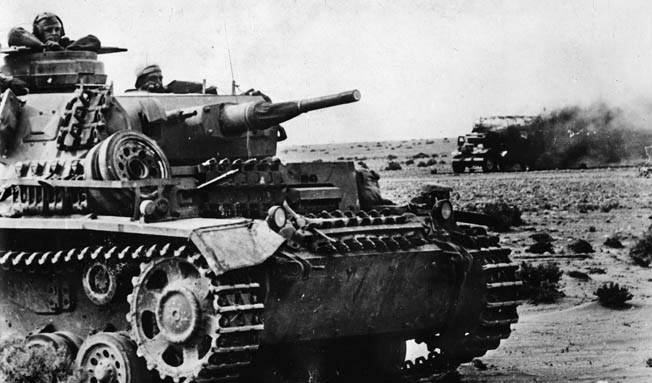
Rommel’s main armored thrust made progress until nightfall when the panzers were halted by artillery fire and attacks on their meager supply lines by fighters and bombers of Air Vice Marshal Sir Arthur Coningham’s Desert Air Force. Convinced of Rommel’s underlying weakness, Auchinleck launched a strong armored counterattack on July 1 that prevented a further advance by the Afrika Korps.
On July 3, after the British routed a converging move by an Italian division, Rommel broke off the battle. He had only 26 serviceable tanks left and little fuel. Both sides were exhausted. Auchinleck pressed his advantage with a series of armored thrusts in the next few weeks, but they were poorly coordinated at the field level. The battle petered out into a stalemate, during which both sides began to sow minefields and set up protective barbed wire entanglements. Reinforcements reached Rommel at the end of July.
Auchinleck had won a vital though partial victory, halting Rommel’s advance to the Nile Delta. The stalemate resulting from the relative failure of the followup attacks gave Auchinleck time to reinforce his positions to a greater extent than Rommel because German shipping in the Mediterranean was under constant attack by the Royal Navy and the Royal Air Force. British and Commonwealth troops, tanks, including 300 new American-built M4 Sherman medium tanks with 75mm main weapons, and field guns poured into the Alamein area during August 1942.
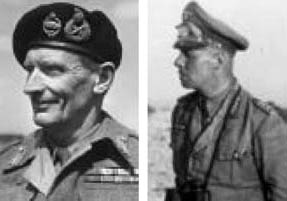
Meanwhile, despite Auchinleck’s skillful leadership, British Prime Minister Winston Churchill had grown impatient for a victory in the Western Desert and could not forgive “The Auk” for the loss of Tobruk. So the prime minister overhauled the command structure, replacing Auchinleck with the handsome Guardsman, General Harold R. Alexander, as Mediterranean commander in chief and naming the able, eccentric Lt. Gen. Bernard L. Montgomery as “new broom” commander of the Eighth Army. Monty replaced Geneneral William H. “Strafer” Gott, who had been killed in a plane crash just after his appointment. Alexander and Montgomery were both decorated, wounded veterans of World War I and heroes of the 1940 Dunkirk campaign.
On his assumption of command on August 13, 1942, the supremely confident Montgomery declared, “Here we will stand and fight; there will be no further withdrawal. I have ordered that all plans and instructions dealing with further withdrawal are to be burnt at once…. The great point to remember is that we are going to finish with this chap Rommel once and for all. It will be quite easy. There is no doubt about it. He is definitely a nuisance. Therefore we will hit him a crack and finish with him.”
As the Eighth Army regrouped and prepared for a new offensive, it received a significant morale boost on August 23—a visit from Churchill during his return from talks in Moscow with Soviet Premier Josef Stalin. Puffing on a familiar Havana cigar, wearing a pith helmet, and carrying an umbrella to ward off the hot desert sun, the buoyant prime minister inspected armor and gun positions, lunched and sipped beer with Monty’s officers, and greeted cheering soldiers with V for Victory salutes.
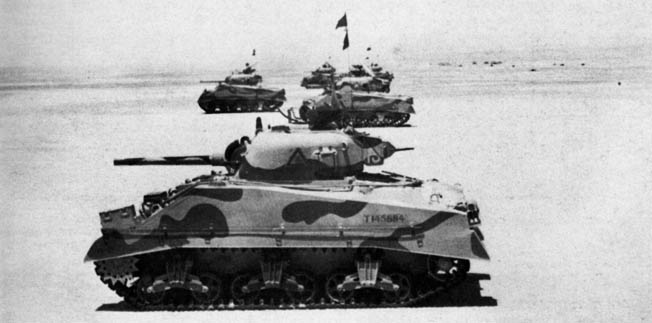
The army’s new leadership maintained and strengthened Auchinleck’s defensive plan for the Alamein position, which offered only one possible attack point for Rommel’s next offensive at the end of August, precipitating the battle of Alam Halfa. On the night of August 30, Afrika Korps armored and infantry units attacked to the south of Alamein between the Alam Nayil ridge and the Qattara Depression. Rommel now had 200 panzers and 240 vulnerable Italian tanks, while Montgomery could field 700 tanks. These included a number of American-built Grant (Lee) and some of the new Shermans, which could outperform Rommel’s standard PzKpfw. III medium tanks. U.S.-built Stuart light tanks, known to the British as Honeys, also supplemented the Eighth Army’s armored array of Cruisers, Crusaders, Covenanters, Valentines, Matildas, Churchills, and Bren gun carriers.
The skilled, audacious German commander hoped to surprise the British with a dawn raid in their rear after an eastward drive, but the enemy force got bogged down in a deep minefield. It was caught by RAF planes the next morning after an advance of only a few miles. Rommel then turned north across difficult soft terrain toward the British position at Alam Halfa, guarded by the 22nd Armored Brigade. Three veteran panzer divisions and the Italian XX Corps attacked, pressing back the British 4th Armored Brigade. But the enemy forces were pinned down by RAF bombers and deadly artillery fire, and their fuel shortages became critical. When Montgomery brought up his other two armored brigades on September 2, Rommel began a gradual withdrawal.
Unwilling to risk his precious tanks in pursuit, Monty called for the staunch 2nd New Zealand Division on the Alam Nayil ridge to close off the enemy retreat. But the Kiwis’ attack on the night of September 3 was disrupted by panzer units guarding Rommel’s flank, and the withdrawal proceeded unhindered. By September 6, the German and Italian forces were entrenched on high ground east of the original front, and the British called off the battle.
For a loss of 1,750 men and 68 tanks, the Eighth Army had again defied the wily Desert Fox, inflicted about 3,000 casualties, and knocked out 51 of Rommel’s precious tanks. Another opportunity to inflict a decisive defeat on the Afrika Korps had been lost, but the Alam Halfa action marked a watershed in the Western Desert war. The enemy forces never again came so close to offensive parity in North Africa, and both sides were now aware that Rommel could no longer hope for an outright victory. After a string of battlefield successes that had mesmerized the world, he had shot his bolt.
Suffering from chronic catarrh, nasal diphtheria, and poor circulation, Rommel was ordered to return to Germany for sick leave and rest. He left in command his deputy, the monocled, good-humored General Georg von Stumme. The balance of power—and morale—in North Africa, meanwhile, had swung in the hard pressed Eighth Army’s favor.
Montgomery, the self-confident, peppery son of the Anglican Bishop of Tasmania and a stern mother, strove to revive the spirit of the Eighth Army. The world’s first multinational fighting force was formed on November 16, 1941, and its shoulder flash was a Crusader’s cross. The army’s new commander displayed a knack for making complex issues appear simple, ruthlessly purged underachieving officers, and made meticulous preparations for an all-out offensive, Operations Lightfoot and Supercharge, to crush the Afrika Korps once and for all.
Although his manner as an outspoken, brusque maverick earned him the enmity of many peers and superiors, Monty had a flair for winning the confidence of his troops. One Eighth Army soldier said of him, “Most awkward to serve alongside, impossible to serve over, he was an excellent man to serve under.” Wearing his familiar black Royal Tank Corps beret or an upturned Australian bush hat, Montgomery made a point of keeping his officers and men aware of his plans. Few generals in World War II kept their men as well informed about operations as Montgomery.
Major General Sir Francis de Guingand, his amiable, invaluable chief of staff, reported, “He very rightly had decided that in order to get the best out of his troops, it was necessary for them to know the whole plan so that they would realize how their particular contribution fitted in with the general scheme of things.”
Cheerful and confident, Monty mingled regularly with the troops to deliver pep talks and sometimes hand out cigarettes, although he was a nonsmoker himself. He believed that “the morale of the soldier is the greatest single factor in war.” Standing on the hood of a truck or jeep as they gathered around him, he told the soldiers crisply, “There will be no more retreat.” He drummed in the need to retain the initiative always and to “kill Germans—even the padres, one per weekday and two on Sundays!”
Supported fully by Alexander, Monty built and maintained morale and physical fitness among the officers and men. Units were retrained in night movements and mine clearance; a complex artillery plan was worked out, and main unit and equipment sites were carefully camouflaged. Dummy transport, supply dumps, and staging areas were established behind the south end of the Alamein line, and radio traffic was stepped up. The aim was to make the Germans think that no attack would be launched before November.
On the enemy side, General Stumme suffered a fatal heart attack, leaving General Ritter von Thoma in temporary command of the Afrika Korps during Rommel’s absence.
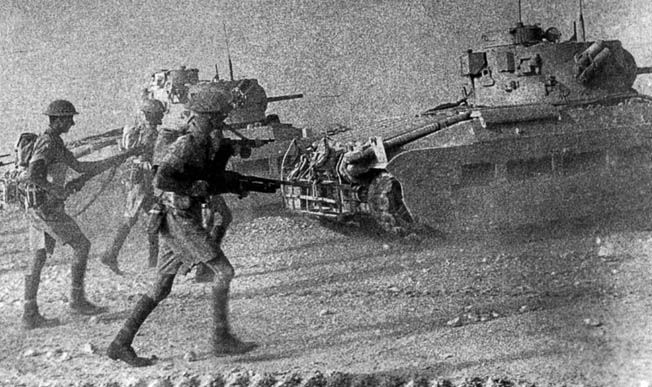
Under Montgomery’s meticulous planning and single-minded resolve, the Eighth Army was honed to a new fighting pitch. Additional units, armor, vehicles, and upgraded equipment arrived in the Alamein area, including the highly effective 6- and 17-pounder antitank guns. By mid-October 1942, Monty’s army was ready with nine infantry and three armored divisions. His three corps, the 30th, 13th, and 10th, were led respectively by Lt. Gen. Sir Oliver Leese, Lt. Gen. Brian G. Horrocks, and Lt. Gen. Herbert Lumsden.
The Eighth Army’s ranks comprised 195,000 men of many proud brigades and regiments—British Guards, the Black Watch, the Gordon Highlanders, the Camerons, English Yeomanry, New Zealanders, Australians, South Africans, Indians, Canadians, Free French, Greeks, and Poles. The army had by now amassed 1,029 tanks, including 216 Crusaders, 194 Valentines, 252 Shermans, and 170 Grants, along with 2,311 artillery pieces. Facing the Allied force were 104,000 German and Italian troops, 489 tanks, of which 300 were inferior Italian models, and 1,219 guns.
The Eighth Army was fine tuned and ready for the great offensive on Friday, October 23, 1942. In a personal message read out to all troops, General Montgomery said, “The battle which is now about to begin will be one of the decisive battles of history. It will be the turning point of the war…. Together we will hit the enemy for six, right out of North Africa…. And let no man surrender so long as he is unwounded and can fight. Let us pray that the Lord mighty in battle will give us the victory.”
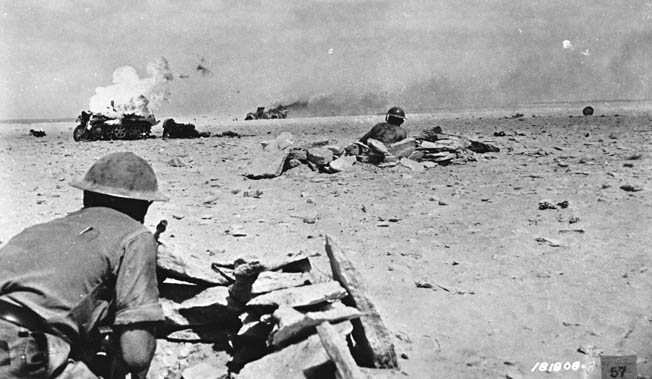
During the daylight hours of October 23, the assault troops were confined to their slit trenches and could not abandon cover even to use the latrines. Night came, and the moon rose full over the desert. Infantrymen waited tensely in their trenches, sappers stood ready with mine detectors to lead the way through enemy minefields, and the black-bereted crews of Monty’s “ironsides” primed up their tanks.
At 9:40 pm, all hell broke loose as 1,000 guns of various calibers—including big 4.5-inchers, 25-pounders, and 3.7-inch antiaircraft guns—opened simultaneous fire upon German artillery emplacements from along the 30-mile British line. The biggest artillery barrage since World War I rained steel and high explosives on the known German and Italian positions and ammunition dumps. The night sky was rent with blinding flashes and man-made thunder, and the desert floor vibrated for many miles. In 20 minutes, the British barrage wrought terrible havoc among the enemy gun positions.
At 10 pm, the artillery switched its targets and deluged the enemy’s forward troop positions. As a choking curtain of dust and smoke towered over the enemy defenses, the first waves of infantry from the British 13th and 30th Corps moved out. White tape and shaded hurricane lamps marked their starting line. To the plaintive skirling of highland bagpipes, line after line of British and Commonwealth infantry moved methodically forward through the hellish din.
Sappers anchored white tape with rocks to guide the soldiers through the enemy minefields. Rommel’s “Devil’s Gardens” of mines, bombs, and barbed-wire entanglements were far deeper than had been calculated by Monty’s planners. Some minefields stretched for five miles.
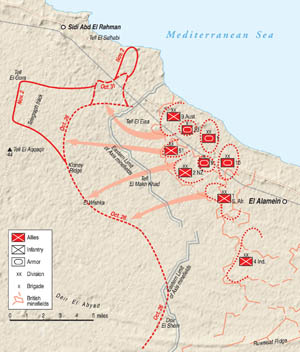
The infantry surged steadily forward as moonbeams glinted on their fixed bayonets and rifles were held at the high port position. The great offensive was underway, and nothing would stop it. With new strength and a revived spirit, the Eighth Army had taken the road to eventual victory. Its commander, meanwhile, had calmly gone to bed in his field caravan headquarters, believing that he would serve his men best by getting a good night’s sleep.
As the initial waves of British infantry advanced, Monty’s tanks began to move forward. Signal pennants fluttered on turrets as columns of Covenanter, Crusader, Valentine, Sherman, Churchill, and Grant tanks kicked up dust clouds, rumbling and clanking along ridges and the desert floor to breach the enemy lines.
In the northern sector, the 9th Australian and 51st Scottish Infantry Divisions went in with fixed bayonets to force a corridor through minefields, while below them the New Zealand and South African divisions attacked to carve out a southern corridor. From the dangerous salient on the Ruweisat Ridge, the 4th Indian Division began a strong raid into the enemy positions, and at the northern end of the Alamein line an Australian brigade made a diversionary attack between Tel el Eisa and the sea.
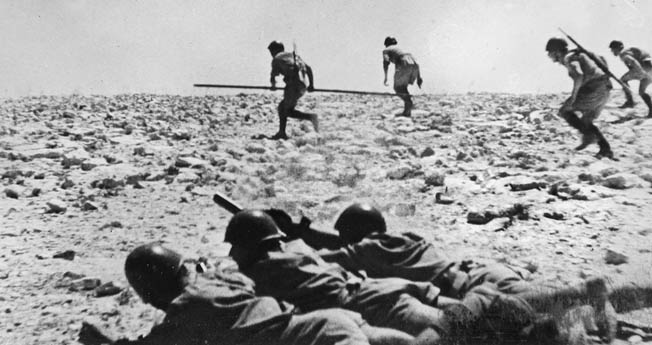
The Germans fought back bravely, but by 5:30 amon October 24, the major British objective had been achieved. Two vital corridors had been opened up, and behind the infantry the 30th Corps divisions and the 1st and 10th Armored Divisions of the 10th Corps were moving in. But at this point, Montgomery’s precise timetable went wrong. Increasing enemy fire swept the infantry in the minefields. Although the 9th Armored Brigade and the 2nd New Zealand Division managed to push forward of Miteiriya Ridge, the 10th and 1st Armored Divisions were checked on a narrow front behind the slowing infantry. However, several panzer counterattacks were beaten off.
The enemy resistance was fierce, and British casualties mounted. Much armor was lost to enemy fire, and many setbacks bedeviled the British advance.
In the south of the Alamein line, the 7th Armoured “Desert Rats” Division and the 44th Infantry Division failed to get through the minefields north of Himeimat, and the 13th Corps infantry embarked on a bloody struggle to implement Montgomery’s “crumbling” tactics. In the extreme south, an advance by the Free French was thrown back before their armored support could reach them. Although the night attack had secured a bridgehead in the enemy positions, when day came on October 24 the armor had failed to penetrate the minefields and the main German defense line had not been breached. Conditions were precarious for British tanks thrusting into the channels opened up by the infantry.
The Scottish infantry and the 1st Armored Division renewed their attack on the afternoon of October 24, and by dusk tanks of the 2nd Armoured Brigade had blasted their way through. But the 10th Armoured Division, following a massive artillery barrage, still encountered stiff resistance in the southern corridor. Monty ordered it to continue attacking despite casualties.
After two days of heavy fighting, the British offensive was losing impetus. The infantry had moved ahead rapidly, but the supporting armor had been slowed down by mines and soft ground. Losses were heavy, and the assault units were exhausted. There had been much brutal hand-to-hand fighting. Montgomery paused and made plans for a new offensive.
By daylight on October 25, the leading British armored brigade had managed to fight its way 2,000 yards through the enemy minefields, while the 9th New Zealand Armoured Brigade also reached its objective. Attempts by the Afrika Korps to destroy these salients were repulsed at heavy cost. Now that his armored spearheads had penetrated the enemy line and established positions from which they could challenge any counterattacks, Monty stepped up the “crumbling” assaults by his infantry.
Meanwhile, Nazi dictator Adolf Hitler ordered Field Marshal Rommel back to Egypt, where he characteristically made his presence known on the battle lines. At Kidney Ridge, northwest of Miteiriya Ridge, on October 27, men of the British Rifle Brigade and tanks of the 1st Armoured Division made an epic stand against successive assaults by German and Italian armor led personally by Rommel. The savage counterattacks were all repulsed, and the 1st Armoured Division alone destroyed 50 panzers that day. The massed panzers were eventually dispersed in furious attacks by Bristol Beaufighters, Douglas Bostons (A-20s), Hawker Hurricanes, North American B-25 Mitchells, and Curtiss Tomahawks and Kittyhawks (P-40s) of the Desert Air Force.
Montgomery went back on full offensive on October 28-29, telling Brigadier John Currie, commander of the 9th Armoured Brigade, “I am prepared to accept 100 percent casualties.” At 1 amon November 2, with a barrage of 300 guns, Monty launched Operation Supercharge against the Italian Trento Division. Spearheaded by British and New Zealand infantry and the 9th Armoured Brigade, the new blow breached the enemy lines. The 151st and 152nd Brigades reached their objectives, and the 1st Armoured Division eliminated its opposition. After a conference with General von Thoma on the night of November 2, Rommel decided to begin a withdrawal to the Fuka position.
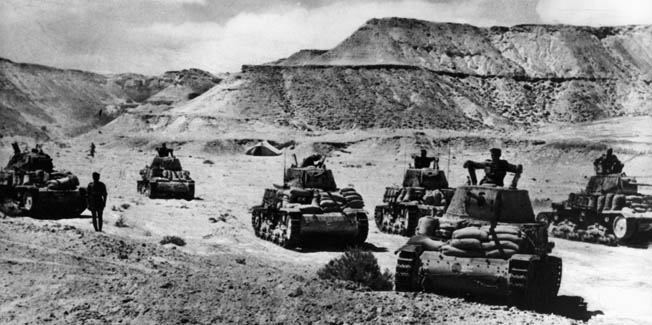
Brutal fighting continued as the Eighth Army infantry, gunners, and tankers battered against stolid enemy resistance. Desperate tank battles raged, and losses were heavy on both sides. German counterattacks withered as British armor, supported by artillery and Desert Air Force bombers, poured through gaps torn in the enemy lines. After confused fighting on the night of November 3, a breakthrough was achieved in the south by the 51st Scottish Infantry and 4th Indian Divisions.
On the sunny morning of the 4th, tanks of the British 22nd Armoured Brigade breached Rommel’s defenses in strength and severed the Rahman Track, the main enemy supply line from the Mediterranean coast into the desert. The Axis forces began to retreat, pursued by the 1st, 7th, and 10th Armoured Divisions. Hard forward drives along the coast road by Lt. Gen. Leslie “Ming the Merciless” Morshead’s 9th Australian Division, meanwhile, played a key role in swinging the whole battle in favor of the Eighth Army, and there was now no stopping Montgomery’s forces.
On November 4, General Alexander reported to Prime Minister Churchill, “After 12 days of heavy and violent fighting, the Eighth Army has inflicted a severe defeat on the German and Italian forces under Rommel’s command. The enemy’s front has broken, and British armoured formations in strength have passed through and are operating in the enemy’s rear areas…. The RAF have throughout given superb support to the land battle and are bombing the enemy’s retreating columns incessantly. Fighting continues.”
The Desert Fox realized that his forces were doomed unless he withdrew. In a letter to his wife, he said, “The battle is going very heavily against us…. At night, I lie open-eyed, racking my brains for a way out of this plight for my poor troops…. The dead are lucky; it’s all over for them.”
Rommel warned Hitler on November 2 that his army was without fuel and faced annihilation. Thanks to British ULTRA code breakers, the signal was in Montgomery’s hands the next morning. But that day Rommel had received an urgent order from Hitler telling him to hold the El Alamein position to the last man. “There is to be no retreat,” said the Führer. “Not so much as one millimeter; victory or death!” Rommel knew this was suicidal nonsense, but he was a soldier who rigidly obeyed orders.
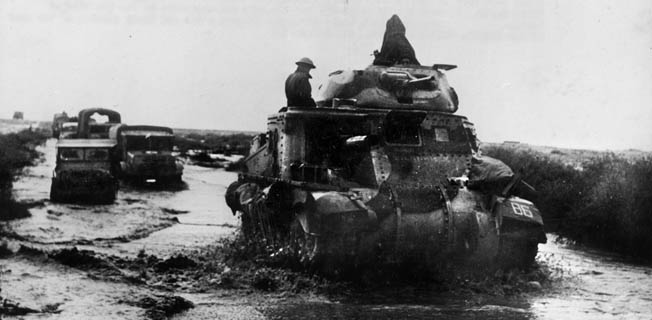
A night attack by the crack 51st Highland Division overran its objectives, and on November 4 General Leese’s 30th Corps pushed through the enemy lines at Tel el Aqqaqir, bringing the 12-day Battle of El Alamein to a close.
The stubborn Rommel had resisted calling for a retreat, but as his defenses caved in he finally received permission from Hitler on the evening of the 4th to withdraw. The pullout, however, had already begun, with Rommel turning a blind eye when General von Thoma sent columns of the Afrika Korps moving westward. Driving out into the desert to investigate a report that Eighth Army armor had broken through to the south, von Thoma was surrounded by British tanks and forced to surrender. Nine Italian generals were also in British hands.
Tough, stocky General Fritz Bayerlein assumed command of the battered Afrika Korps as it began a headlong but masterly westward retreat across Libya, leaving behind the desert battlefield littered with burned-out panzers and shattered flak guns, and abandoning its Italian allies. Tanks of the 1st, 7th, and 10th Armoured Divisions followed the fleeing Germans, and fighters and bombers of the Desert Air Force mercilessly harassed their long columns jamming the coast road.
Because of the toll taken by the Desert Air Force on the Axis transport and the critical shortage of fuel, there were only enough vehicles to get the surviving German troops away. With sparse food and water, and loath to retreat on foot in the face of relentless strafing and bombing, the men of six Italian divisions surrendered by the tens of thousands to the advancing British.
Montgomery sought to swing his main armored force northward and around the retreating Afrika Korps to block the coastal road at the bottlenecks of Fuka and Mersa Matruh, but he chose to be cautious. He had a healthy respect for Rommel’s proven ability to hit back when all seemed lost, so Monty refused to allow the 10th Armoured Division to go all out for Sollum and Tobruk. Nevertheless, a large number of prisoners, tanks, and trucks was headed off and captured by the 8th Armoured Brigade.
Then, even as it had saved Rommel during the earlier Crusader campaign, the weather came to the rescue of the Afrika Korps. Within minutes as the New Zealanders bore down on Fuka and the 1st and 7th Armoured Divisions converged on Mersa Matruh, a blinding deluge of rain turned the firm going into a treacherous quagmire. It rained for two days, and on November 7, Montgomery’s whole pursuit force was bogged down. There was now no way to cut off what remained of the Afrika Korps. Although the Desert Air Force pressed home damaging attacks, the Germans were able to make good use of 24 hours of respite, and most of the surviving enemy troops got away along the coast road. Although four crack German divisions and eight Italian divisions had been annihilated, Rommel still had a compact and formidable force of armor, guns, and vehicles.
But time was running out for the Desert Fox and his army. During Operation Torch 100,000 British and American troops landed in Algeria and Morocco on the morning of November 8, 1942, and Rommel’s fleeing army found itself boxed in between them and the advancing Eighth Army.
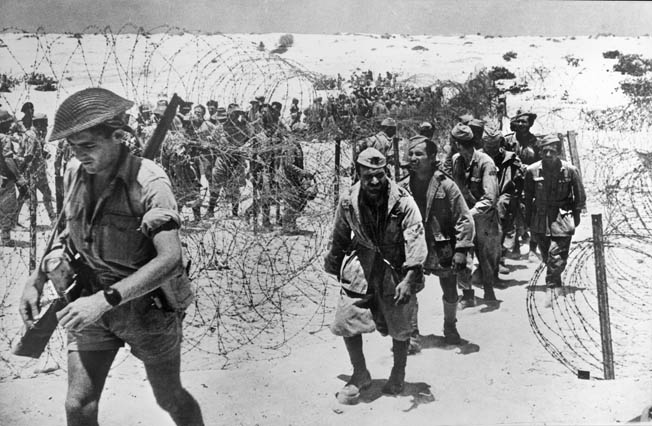
The Battle of El Alamein, the climax of the Western Desert campaigns and the first major turning point of World War II, was costly to both sides. The Afrika Korps lost about 20,000 men killed and wounded, and 30,000 prisoners were taken. Axis tanks destroyed or damaged totaled 450, and the Italians abandoned 75 due to lack of fuel. At least 1,000 enemy guns were destroyed. The battle cost the Eighth Army 13,560 men killed and wounded, 150 tanks knocked out, and 100 guns lost.
When news of the victory was flashed to Britain, spirits soared. The island nation’s hard-pressed people, subjected to more than two years of bombing, severe rationing, and inured to a series of military defeats from Singapore to Norway to Crete, rejoiced at the headlines and radio broadcasts. On Churchill’s order, church bells rang out in cities, towns, and villages on Sunday, November 15. They had been held silent for almost two years and would otherwise have been rung only as an invasion alarm. As loudspeakers crackled the tidings in war production plants, weary workers broke out in cheers.
“There’s plenty more where that came from,” said one woman lathe operator.
Churchill was ecstatic. “Before Alamein, we never had a victory,” he said later. “After Alamein, we never had a defeat.” In a cheerful speech during the annual Lord Mayor’s lunch at London’s Mansion House on Tuesday, November 10, the prime minister pronounced El Alamein “a remarkable and definite victory” and said, “The bright gleam has caught the helmets of our soldiers…. Now, this is not the end. It is not even the beginning of the end, but it is, perhaps, the end of the beginning.”
At that time, Rommel’s army was being steadily pushed back to Sidi Barrani, 200 miles west of El Alamein.
General Montgomery was hailed as a national hero as the Eighth Army advanced westward for four bitter months through Bardia, Tobruk, Gazala, Derna, Benghazi, El Agheila, Sirte, Tripoli, Medenine, Gabes, the Mareth Line, and on to a triumphant march into Tunis with flags flying, regimental drums pounding, and bagpipes skirling.
In Tunisia, Monty’s proud, bronzed crusaders joined with troops of Lt. Gen. Kenneth Anderson’s British First Army, Lt. Gen. George S. Patton, Jr.’s U.S. II Corps, and Free French units to crush the remaining Axis resistance in North Africa in March 1943.
The Eighth Army then played a critical role in the capture of Sicily and battled up the craggy Italian boot to Trieste and the Austrian Alps, taking part in the bloody campaigns at Salerno, the River Sangro, Monte Cassino, the Gothic Line, Primasole, Catania, the Gustav Line, Ortona, the Liri Valley, and the Po Valley. It covered more battle miles than any other army in World War II. General Richard McCreery was its last commander when the Eighth Army was unceremoniously disbanded in late July 1945.
Montgomery, meanwhile, had gone on to command the British 21st Army Group and head Allied ground forces in the great invasion of Normandy on June 6, 1944.
The Eighth Army’s finest hour, the Battle of El Alamein, was immortalized on film in Desert Victory, regarded by many as the finest documentary to emerge from World War II. Directed by Roy Boulting and Colonel David MacDonald of the British Army Film Unit and featuring an inspiring score by Sir William Alwyn, it received the 1943 Academy Award for best documentary. Of the 26 cameramen who filmed Desert Victory under fire, four were killed, six wounded, and seven captured.
Prime Minister Churchill sent copies of the documentary to President Franklin D. Roosevelt, Premier Stalin, and the dominion governments. Stalin called Desert Victory “magnificent,” and FDR said it was “about the best thing that has been done about the war on either side … everybody in town is talking about it.”
Author Michael D. Hull is a frequent contributor to WWII History. He writes on a variety of topics and resides in Enfield, Connecticut.
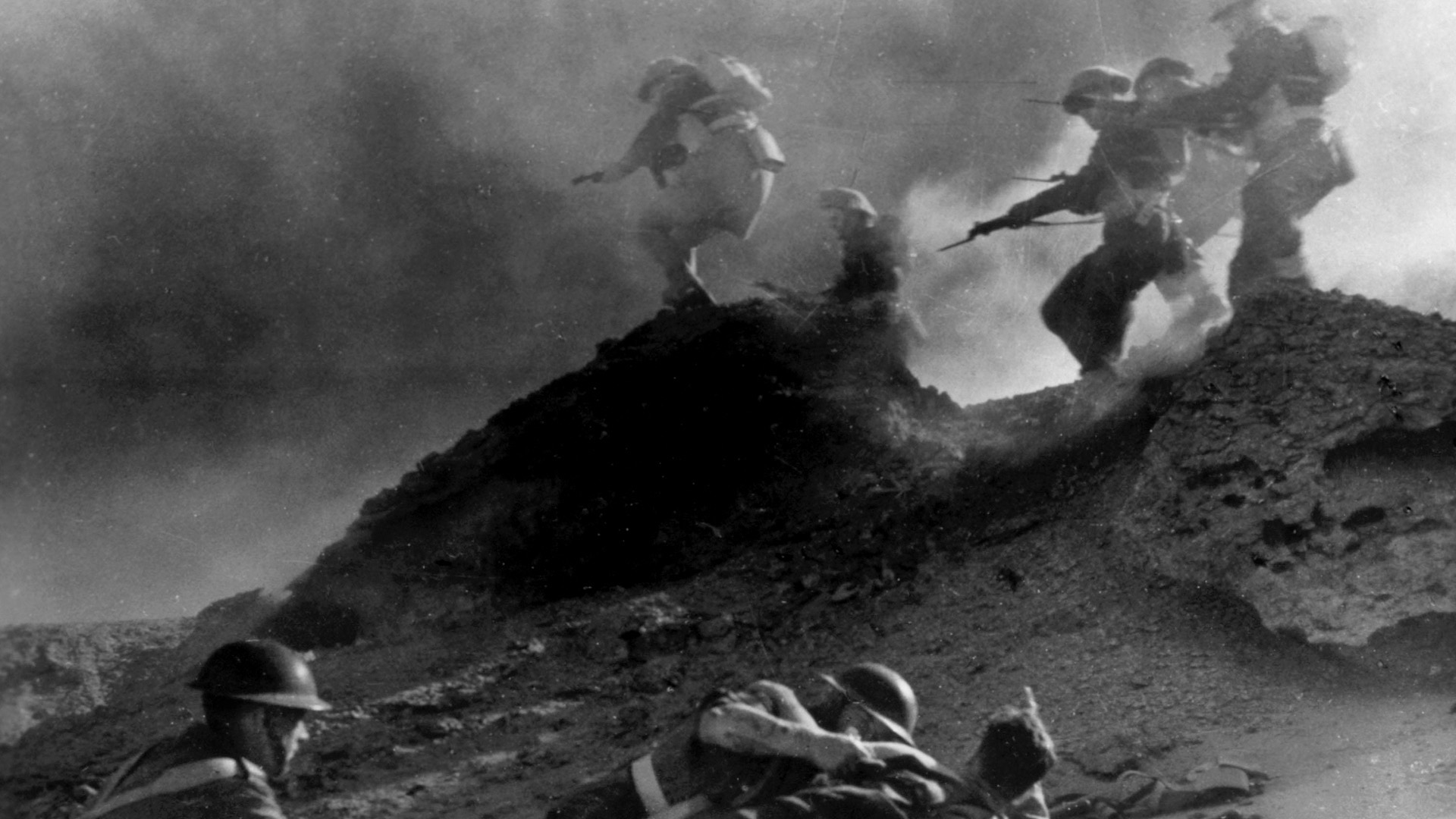
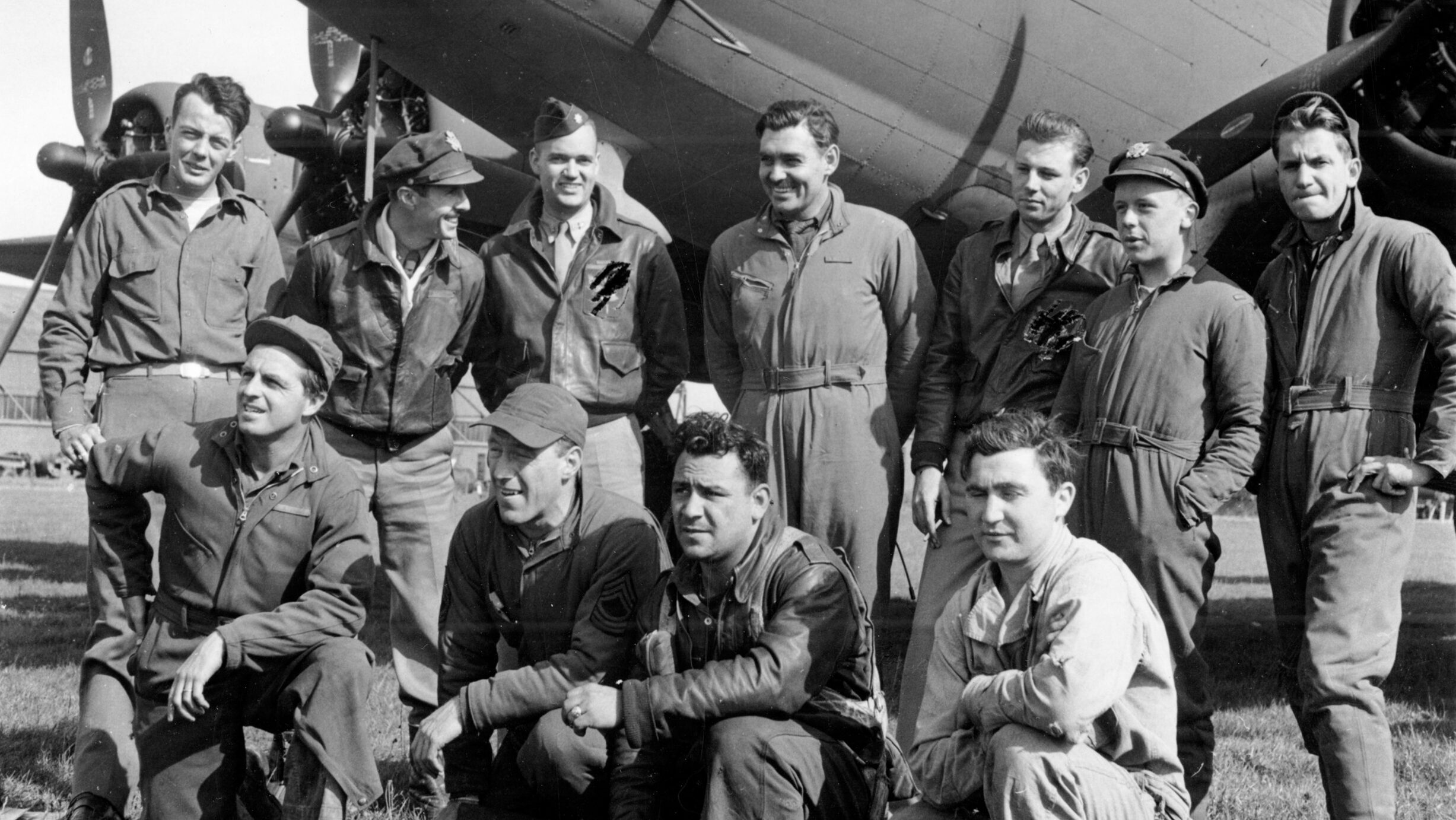
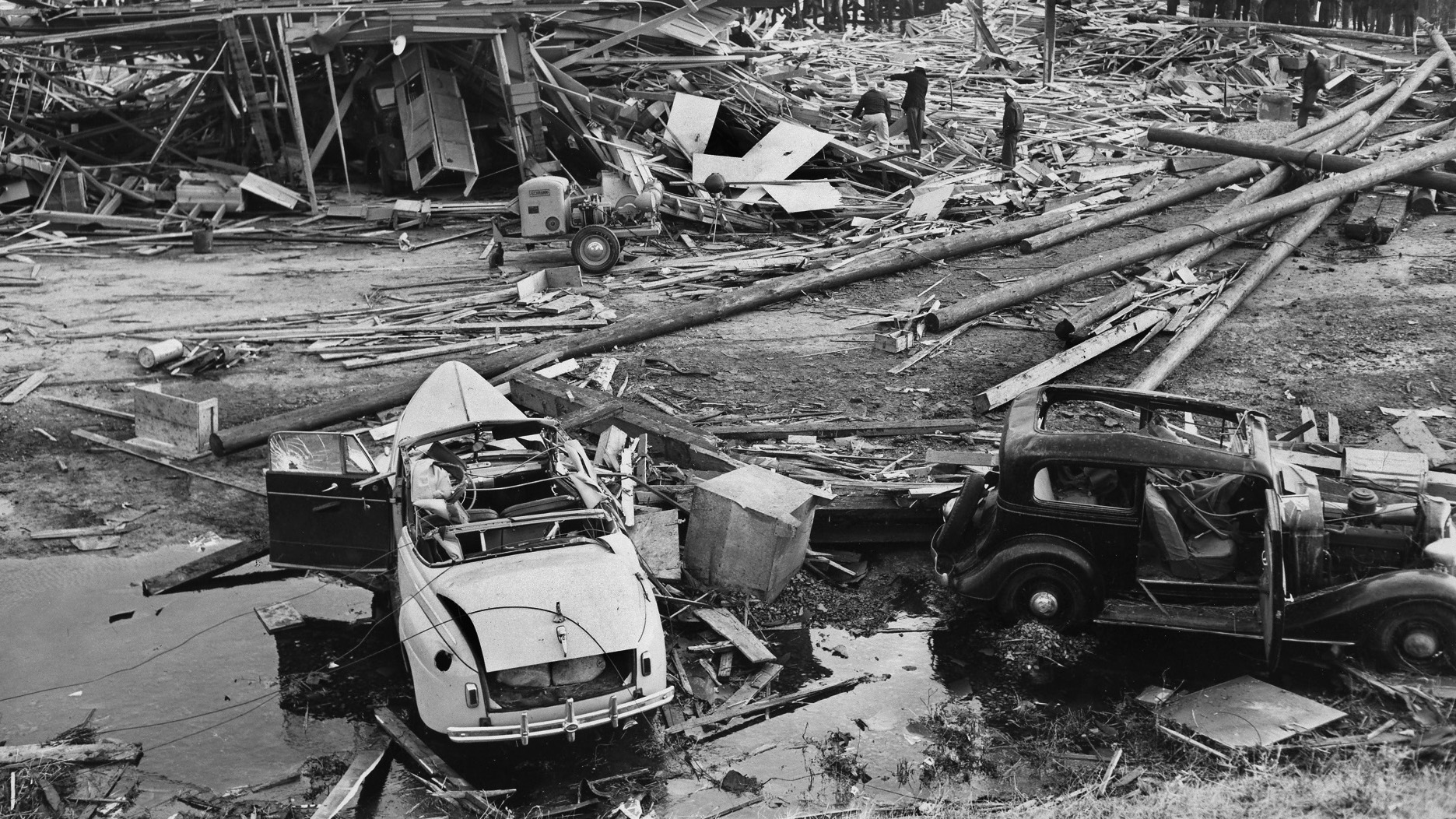
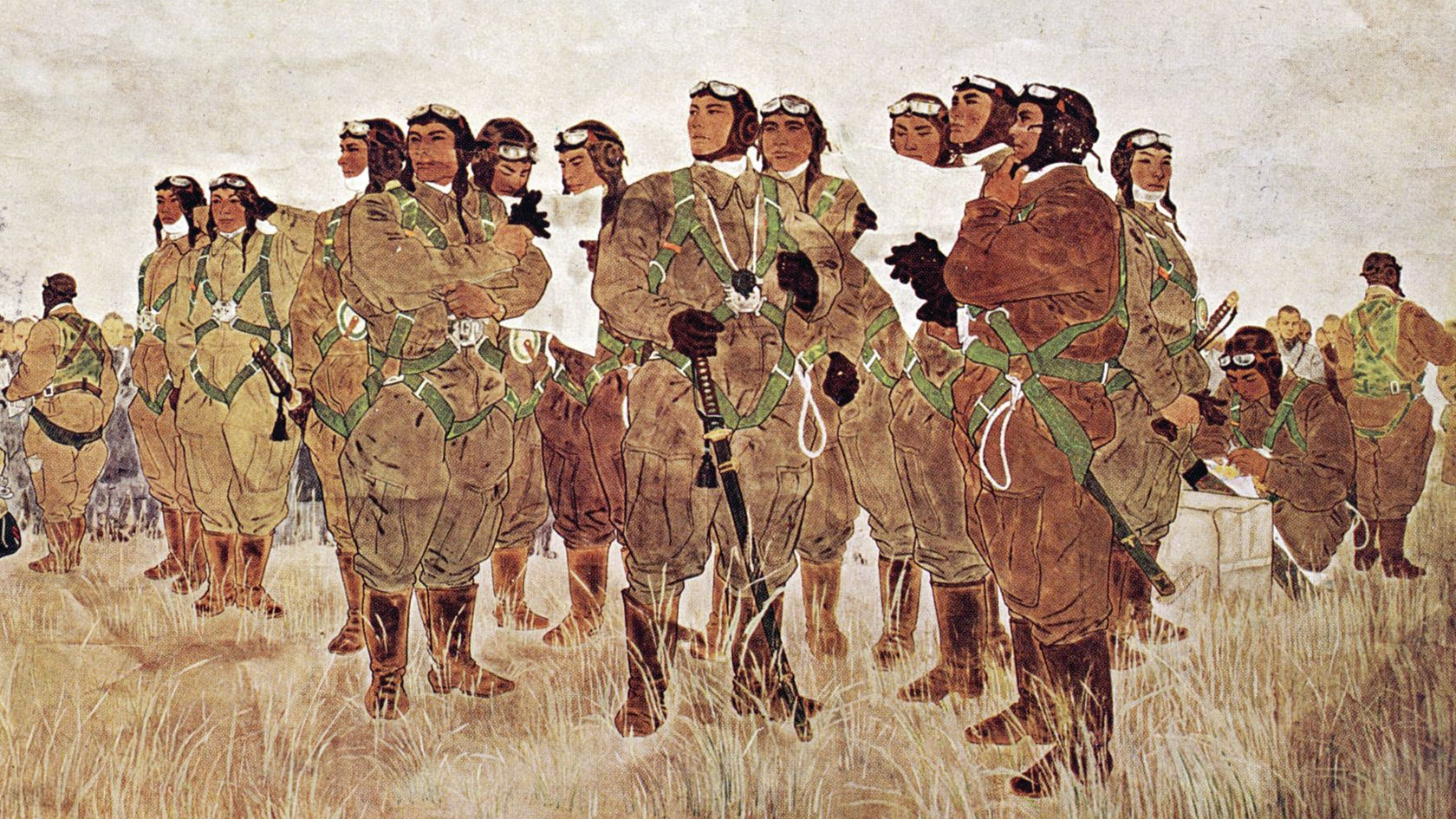
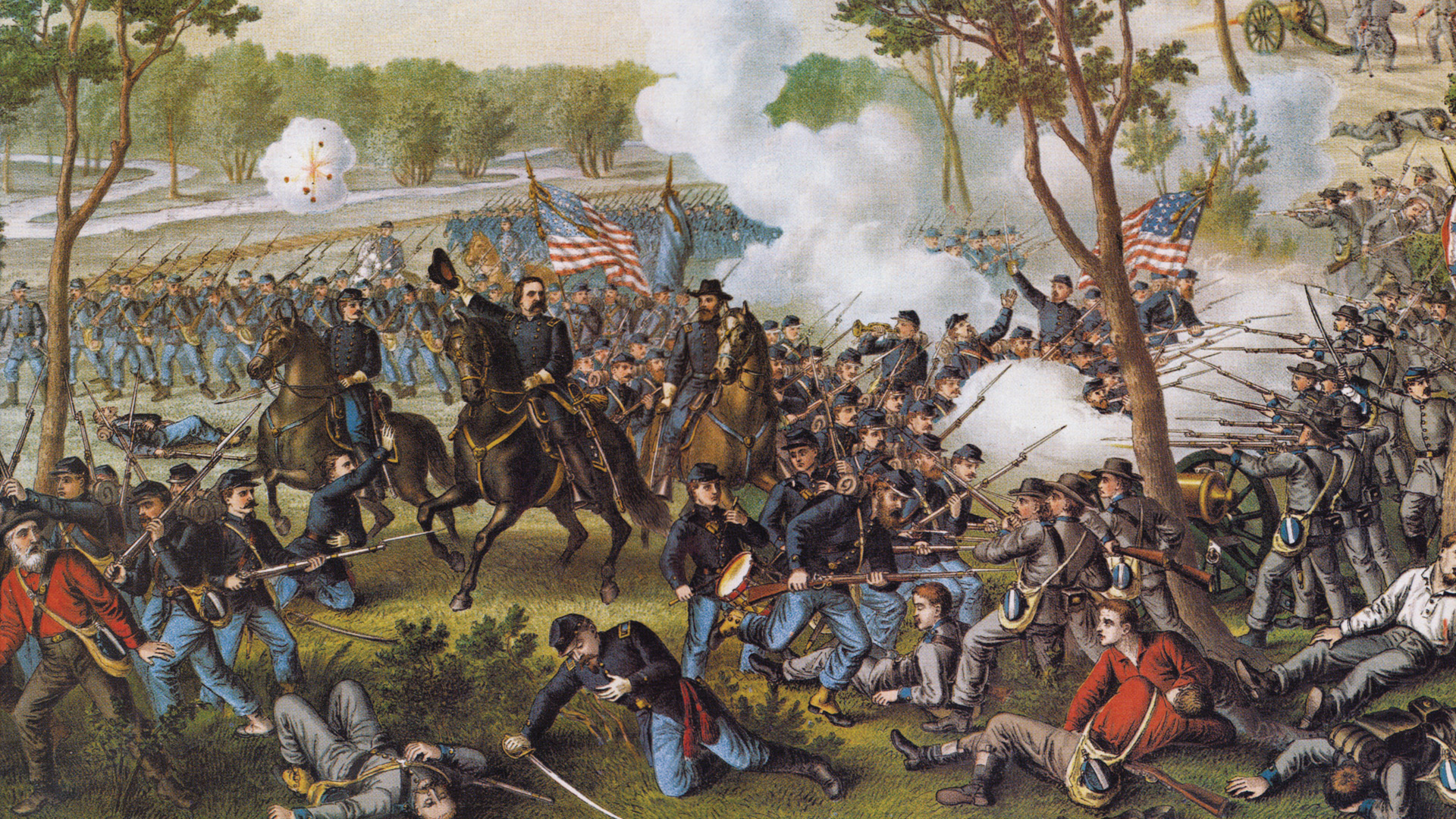
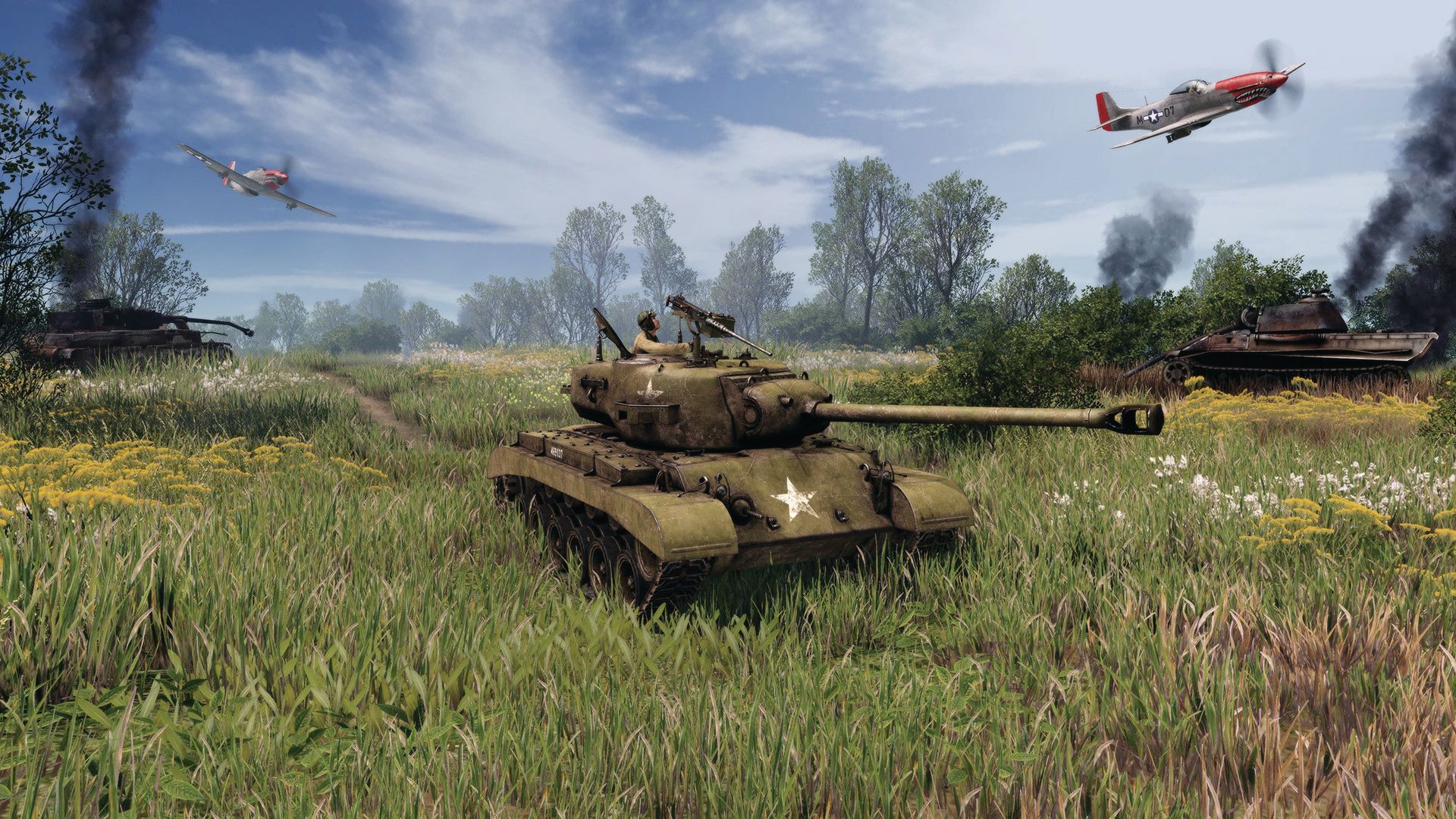
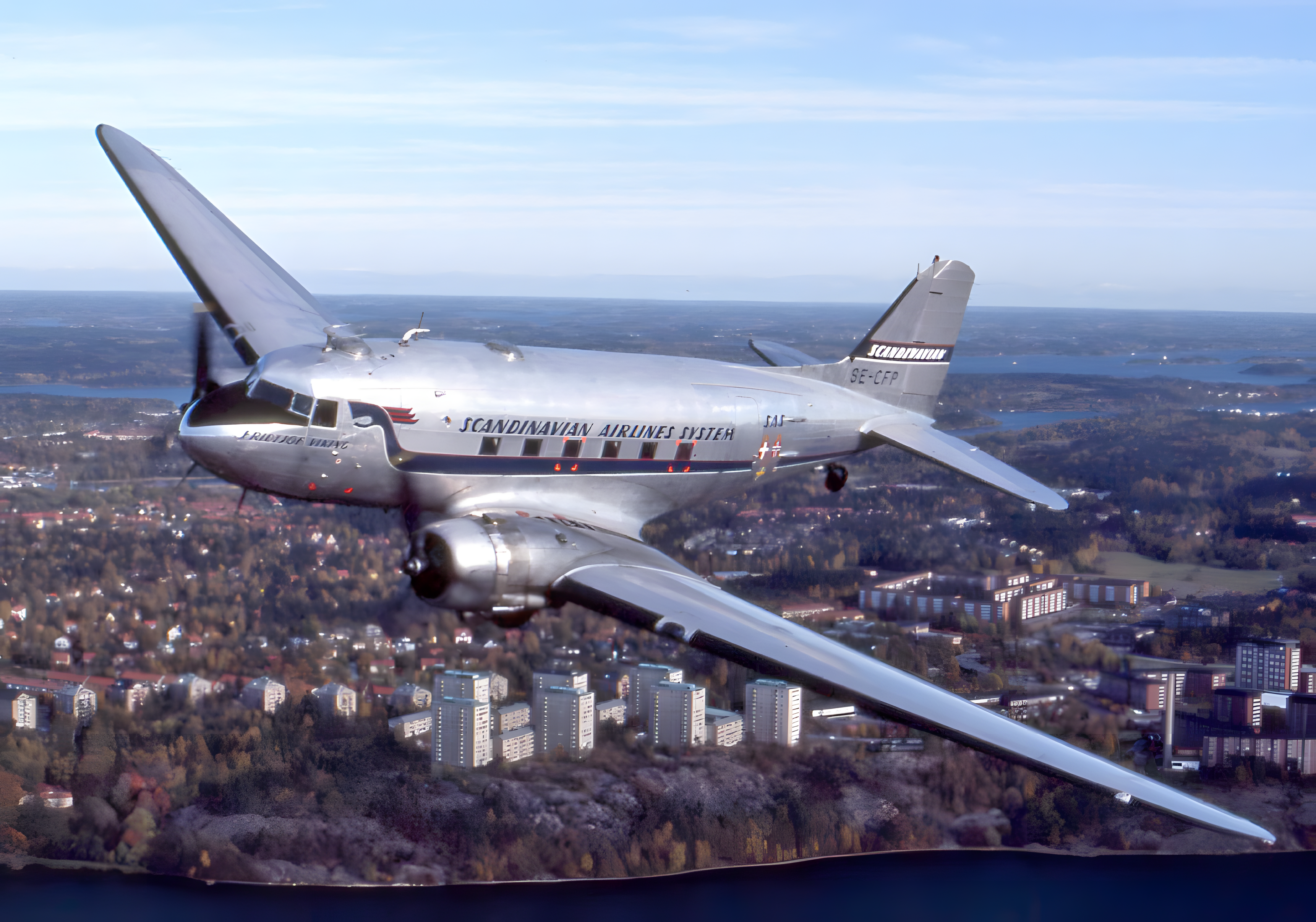
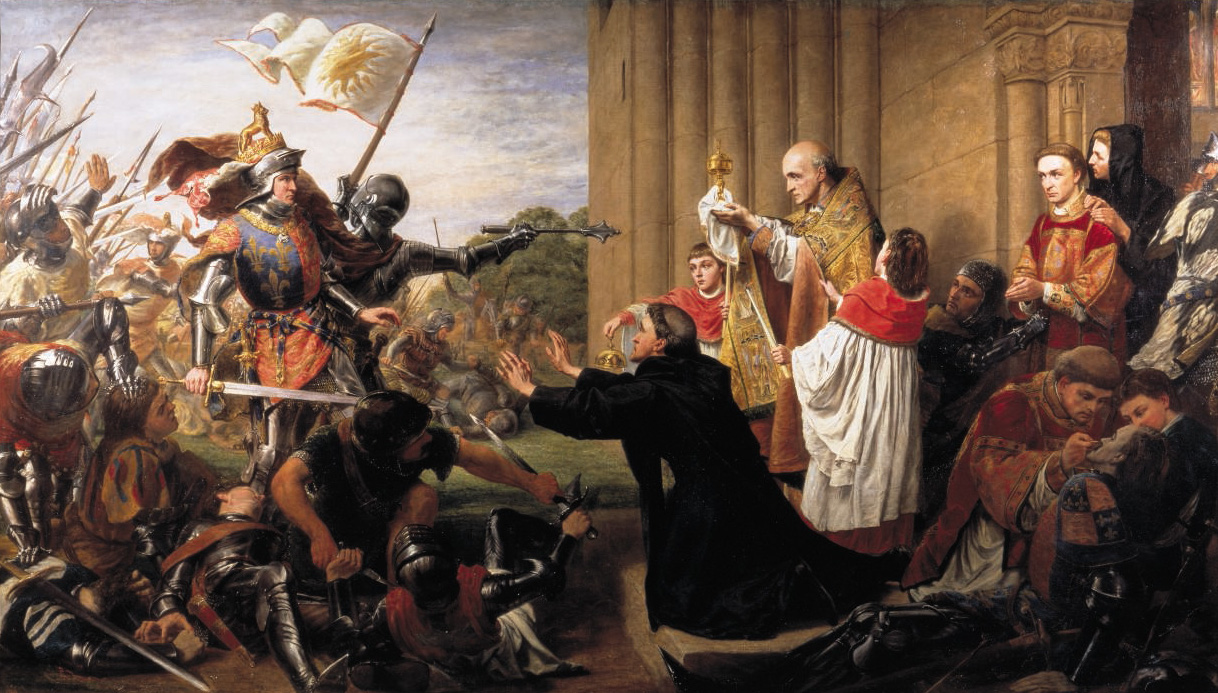
Join The Conversation
Comments
View All Comments